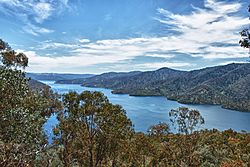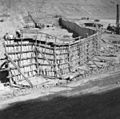Eildon Dam facts for kids
Quick facts for kids Eildon Dam |
|
|---|---|

A view of the impounded Lake Eildon, in 2011
|
|
|
Location of the Eildon Dam in Victoria
|
|
| Country | Australia |
| Location | Victorian Alps, Victoria |
| Coordinates | 37°11′34″S 145°53′49″E / 37.19278°S 145.89694°E |
| Purpose | |
| Status | Operational |
| Construction began | 1915 |
| Opening date |
|
| Operator(s) | Goulburn–Murray Water |
| Dam and spillways | |
| Type of dam | Embankment dam |
| Impounds | Goulburn River |
| Height | 84.5 m (277 ft) |
| Length | 1,085 m (3,560 ft) |
| Dam volume | 10,200×103 m3 (360×106 cu ft) |
| Spillway type | Controlled |
| Spillway capacity | 3,356 m3/s (118,500 cu ft/s) |
| Reservoir | |
| Creates | Lake Eildon |
| Total capacity | 3,390,000 ML (750,000×106 imp gal; 900,000×106 US gal) |
| Catchment area | 3,885 km2 (1,500 sq mi) |
| Surface area | 13,832 ha (34,180 acres) |
| Maximum water depth | 79 m (259 ft) |
| Normal elevation | 288.9 m (948 ft) AHD |
| Power station | |
| Name | Eildon Hydroelectric Power Station |
| Coordinates | 37°13′19″S 145°55′17″E / 37.22194°S 145.92139°E |
| Operator(s) | AGL Energy |
| Commission date |
|
| Turbines | Four |
| Installed capacity | 135 MW (181,000 hp) |
| Annual generation | 226 GWh (810 TJ) |
| Website at Goulburn–Murray Water |
|
The Eildon Dam, also known as Eildon Weir, is a huge dam in Victoria, Australia. It's built across the Goulburn River in the beautiful Victorian Alps. The dam is near the towns of Mansfield and Eildon. It's also part of the Lake Eildon National Park.
This important dam helps us in a few ways. It provides drinking water for people. It also supplies water for irrigation, which means watering farms. Plus, it generates hydroelectricity, which is electricity made from moving water. The big lake formed by the dam is called Lake Eildon.
Contents
Building the Eildon Dam
The first dam at this spot was called Sugarloaf Reservoir. Workers started building it in 1915. It was finished in 1929. The main reason for this first dam was to provide water for farms. These farms were in a large area of Victoria's northern plains.
The dam was made bigger in 1929 and again in 1935. This helped it hold more water. But even then, it wasn't enough for everyone. People in the Goulburn Valley needed more water. Farmers also needed more water during dry years.
So, in 1951, work began to make the dam much larger. This big project was finished in 1955. After this, the storage area was renamed Lake Eildon.
How the Dam is Built
The Eildon Dam wall is made of earth and rock. It stands about 83 meters (272 feet) tall. The wall itself contains about 10.2 million cubic meters of rock and earth.
The dam collects water from a huge area of 3,885 square kilometers (1,500 square miles). This area includes several rivers like the Goulburn, Delatite, Howqua, Big, and Jamieson rivers. Lake Eildon covers a surface area of 13,832 hectares (34,180 acres).
The lake can hold a massive 3,390,000 megalitres of water. Its average depth is about 24 meters (79 feet). The dam has a special part called a controlled spillway. This lets out a maximum of about 3,356 cubic meters (118,500 cubic feet) of water per second.
Water for Cities and Farms
Lake Eildon is connected to Melbourne, Victoria's capital city. A pipeline from the Goulburn River sends water to Melbourne. This helps supply drinking water to the city.
Most of the water from Lake Eildon goes to farms. About 91% of the water flows to the Goulburn Weir and the Waranga Basin. From there, it helps irrigate farms in the Goulburn Valley.
Making Electricity at Eildon
The Eildon Hydroelectric Power Station uses the dam's water to make electricity. It's operated by a company called AGL Energy. This power station usually runs from August to May. This is when farmers need water for their crops.
The power station can also make electricity at other times. For example, during winter or spring, when there's a lot of water from floods. It can even help if there's an emergency and other power plants break down.
History of Power Generation
The first power station at Eildon was small. It could make 15 megawatts (MW) of electricity. By 1957, its power grew to 120 MW. This was thanks to two large turbines.
In 2001, older turbines were updated. These smaller turbines had been moved from another power station. After this upgrade, the Eildon Power Station could make 135 MW of power.
The Eildon Power Station has four large generators. Together, they can produce 150 MW of electricity. On average, it creates about 225 gigawatt-hours (GWh) of electricity each year. That's enough to power many homes!
Houseboats on Lake Eildon
Lake Eildon is a popular spot for houseboats. Many people enjoy living or vacationing on boats here. There are two main areas for houseboats: a Public Harbor and a Private Harbor.
- The Public Harbor offers houseboats for rent. Some of these boats can only be used during the day. This is because they don't have lights for night use.
- The Private Harbor manages over 200 houseboats. These boats are owned by individuals. Both harbors have places where boats can get fuel.
Drought and Recovery
In the 2000s, Victoria faced a long period of drought. During these years, Lake Eildon rarely filled up. This caused problems for holiday towns around the lake. Fewer visitors meant businesses struggled.
Even with the drought, water was still needed for farms. The dam operators carefully managed the water. This helped keep the water flowing to farmers. In November 2006, the lake dropped to only 15% of its full capacity. The year before, it was at 48.3%.
After many dry years, 2010 brought a lot of rain. Lake Eildon started to fill up again. By March 2011, it was 82.5% full. This was a great recovery for the lake and the area.
Eildon Dam in Movies
The town of Bonnie Doon is very close to Lake Eildon. This town was used for the holiday scenes in the famous Australian movie, The Castle. Lake Eildon itself was also a filming location. It was used for the 1989 horror movie Houseboat Horror.
Images for kids






